On next Thursday the 2014 World
Cup will kick off in Sao Paulo. But next week will also see the FIFA members meeting on Tuesday and Wednesday at a
much awaited FIFA congress. For this special occasion we decided to review
FIFA’s financial
reports over the
last ten years. This post is the first of two, analysing the reports and
highlighting the main economic trends at play at FIFA. First, we will study the
revenue streams and their evolution along the 2003-2013 time span. In order to ensure
an accurate comparison, we have adjusted the revenues to inflation, in order to
provide a level playing field easing the comparative analysis over the years
and types of revenues. Our first two graphs gather the main revenue streams
into two comparative overviews. Graph 1 brings together the different types of
revenues in absolute numbers, while Graph 2 lays down the share of each type of
revenues for any given year (the others category covers a bundle of minor
revenue streams not directly relevant to our analysis).
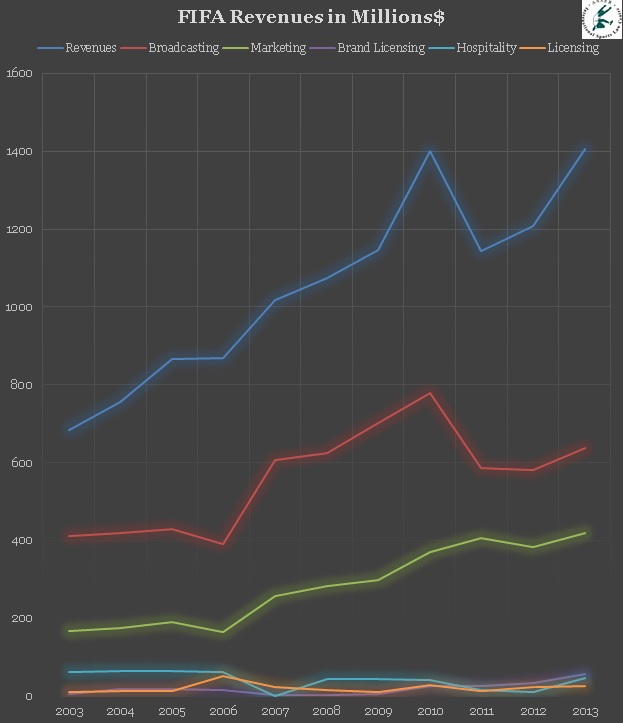
Graph 1: FIFA revenues
in Millions of Dollars, 2003-2013 (adjusted for inflation).
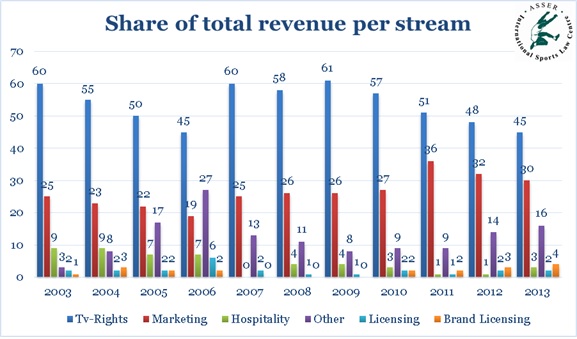
Graph 2: Share of each
revenue stream in Total FIFA revenues 2003-2013
Since 2003, FIFA’s total revenues have more than doubled, from 685
Million$ to 1406 Million$. Its constant growth over the last decade turned
negative only in 2011 and 2012 due to a fallout in broadcasting revenues (see
below Graph 4). In terms of economic power this means that FIFA has doubled its
financial capacity within ten years. It
has succeeded in developing new income streams, while also consolidating its
traditional source of revenue: broadcasting rights.
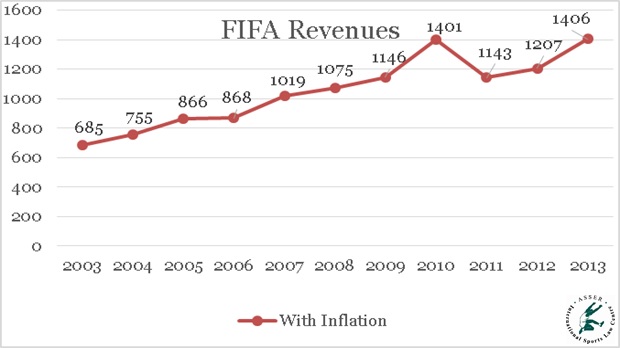
Graph 3: Total FIFA
revenues in Million$ 2003-2013 (adjusted for inflation)
Key to FIFA’s continuous enrichment were the broadcasting revenues. From
2006 to 2010 they nearly doubled from 391 Million$ to 779 Million$. A huge 100%
jump! Since this peak, revenues have settled for a more modest amount of around
600 Million$, but still much higher than at the turn of the century. In any
given year the broadcasting revenues represent 40 to 50% of FIFA’s total
revenues. Thus, one can understand the paramount importance of broadcasting
rights for the economic stability and health of FIFA. The progressive bite of
the revised TV without frontier
directive of the
EU (revised in 1997), enabling countries to define certain World Cup games as “major
events” which therefore must be broadcasted freely, might explain the recent
fall in broadcasting revenues. In this context, recent decisions of the EU Courts, in
cases T-68/08, C‑205/11 P and C‑204/11 P reinforce the rights of the Member States to
make use of the “major events” listing, this could, on the long run, limit the
rise of the broadcasting revenues for FIFA.
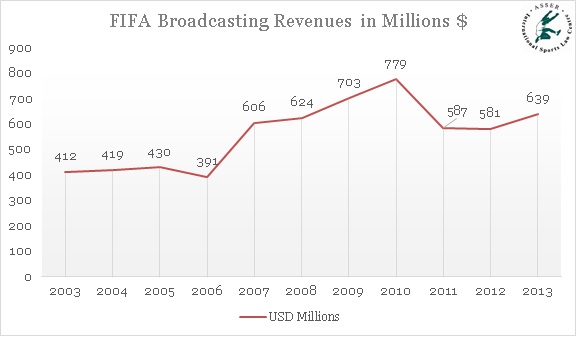
Graph 4: FIFA
Broadcasting Revenues 2003-2013 (adjusted to Inflation)
The marketing rights (see graph 5) constitute the second leg
of FIFA’s financial income stream. They have been constantly growing since
2003. From 168 Million$ in 2003 to 419 Million$ in 2013, reaching quasi 150%
growth (at constant prices). In recent years, this has been a more dynamic revenue
stream than broadcasting rights, but it has remained less important in absolute
terms. It seems that the FIFA Partners Programme launched by FIFA, probably inspired by the TOP Programme created by the IOC, is a tremendous success. Nowadays,
marketing rights constitute 30 to 35% of FIFA’s total revenues. Together,
broadcasting revenues and marketing rights amount to a staggering 75 to 85% of
FIFA’s total revenues. A share which remained more or less stable over the
latest years (see Graph2).
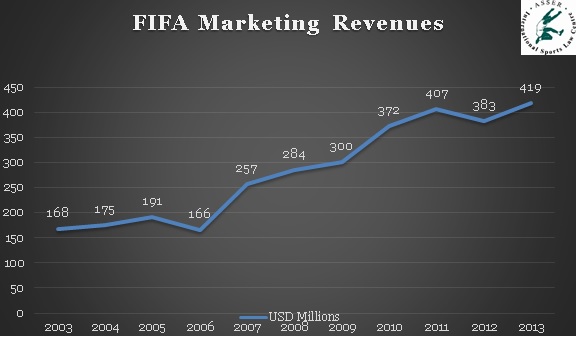
Graph 5: FIFA Revenues
from Marketing rights 2003-2013
The rather minor revenue streams are constituted by the FIFA hospitality
rights, licensing and brand licensing revenues. Hospitality rights revenues (Graph
6) are a relic from the past. They derive from the profits made by MATCH Hospitality, the sole company authorised by FIFA to offer
and guarantee exclusive hospitality packages for every match of the FIFA World
Cup directly or through its appointed sales agents. With the competition of
internet-based travel agencies and the evolution of the ticketing system of
FIFA under the pressure of the
European Commission, the revenues of match hospitality have been dwindling over the last 10
years.
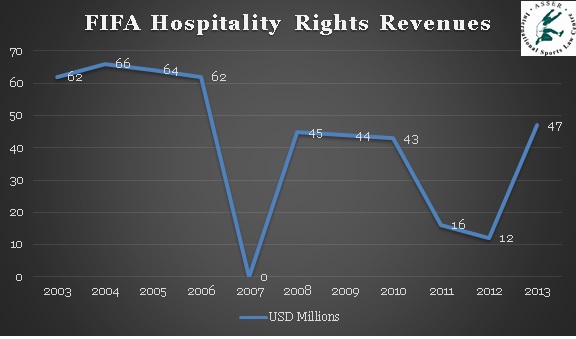
Graph 6: FIFA
Hospitality Rights Revenues 2003-2013 (adjusted for inflation)
The FIFA licensing
programme (Graph
7) derives its revenues from fixed royalty payments and variable profit shares
paid for the use of the FIFA brand. FIFA’s licensing programme covers a broad
range of activities, including for example numismatic and philatelic collections
and the more classical retail & merchandising. After a peak at the World
Cup 2006 in Germany, where FIFA licensing brought in 51 Million$, licensing
revenues have remained more or less stable averaging at 10 to 20 Million$ a
year.
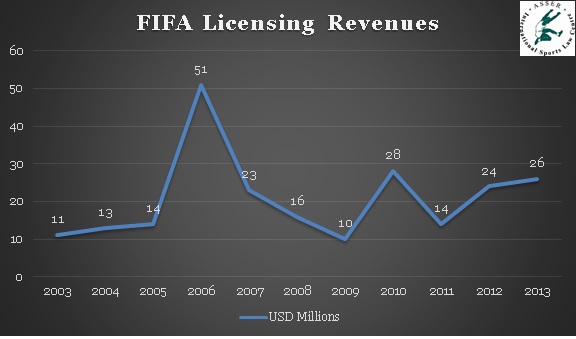
Graph 7: FIFA
Licensing Revenues 2003-2013 (adjusted for inflation)
Another closely related, but distinct for accountancy purposes, income
stream, is the one generated by brand licensing (Graph 8). Five companies dispose of a
specific agreement with FIFA: Adidas, Electronic Arts, Hublot, Louis Vuitton
and Panini. Each of these companies holds a licence to use the FIFA Brand Marks
in the advertising, marketing, promotion and sale of its licensed products or
programmes. These long-term licensing agreements bring in more and more money,
from 5 Million$ in 2003, to 58 Million$ in 2013. The biggest jump for a
category of FIFA revenues. Its success
is exemplified by the world-wide fame of the eponym Electronic Arts video game:
FIFA. However, all three revenue streams amount to less than 10% of FIFA’s
total revenues in 2013, the lion share is still constituted by the broadcasting
rights.
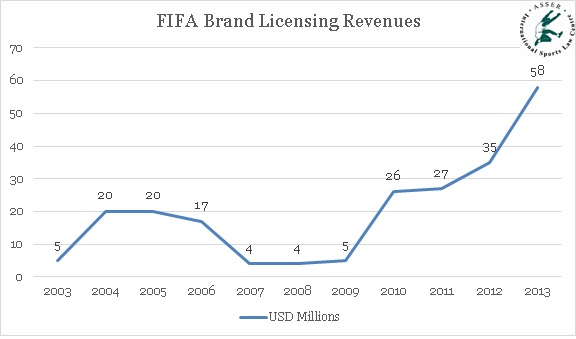
Graph 8: FIFA Brand
Licensing Revenues 2003-2013 (adjusted for inflation)
Conclusion:
Get rich and die getting richer?
Economically the last 10
years have been a phenomenal success for FIFA. Its revenues have grown
substantially and it has, to some extent, managed to diversify its
revenue streams. Indeed, FIFA is less and less dependent on broadcasting
revenues, while relying more and more on marketing and brand licensing income
streams. This diversification appears judicious as the broadcasting market seem
to be losing steam, especially in light of a public will, at least at the
European level, to control and tame the monopoly of FIFA over the broadcasting
of the World Cup. Thus, FIFA is in a paradoxical situation. It will enter its
congress engulfed in an unending governance crisis, but financially it looks as
profitable as ever. In some way the big leap forward of FIFA’s recent, and
highly successful, commercialization might cause the existential crisis it is now
confronted with. Indeed, all this fresh money influx may have destabilized even
more a governance system prone to favour nepotism. Hence, the paradox might be
that FIFA got rich and might die (at least as we know it) because of it. This
is also connected to the way FIFA distributes the revenues it collects, which
will be the focus point of the second part of this blog series.